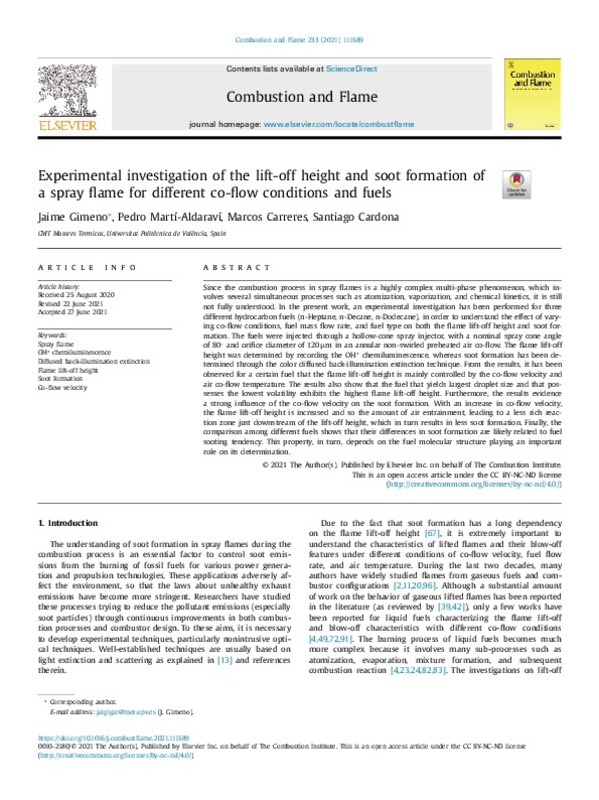JavaScript is disabled for your browser. Some features of this site may not work without it.
Buscar en RiuNet
Listar
Mi cuenta
Estadísticas
Ayuda RiuNet
Admin. UPV
Experimental investigation of the lift-offheight and soot formation of a spray flame for different co-flow conditions and fuels
Mostrar el registro sencillo del ítem
Ficheros en el ítem
| dc.contributor.author | Gimeno, Jaime
|
es_ES |
| dc.contributor.author | Marti-Aldaravi, Pedro
|
es_ES |
| dc.contributor.author | Carreres, Marcos
|
es_ES |
| dc.contributor.author | Cardona-Vargas, Santiago
|
es_ES |
| dc.date.accessioned | 2022-05-17T18:03:48Z | |
| dc.date.available | 2022-05-17T18:03:48Z | |
| dc.date.issued | 2021-11 | es_ES |
| dc.identifier.issn | 0010-2180 | es_ES |
| dc.identifier.uri | http://hdl.handle.net/10251/182656 | |
| dc.description.abstract | [EN] Since the combustion process in spray flames is a highly complex multi-phase phenomenon, which involves several simultaneous processes such as atomization, vaporization, and chemical kinetics, it is still not fully understood. In the present work, an experimental investigation has been performed for three different hydrocarbon fuels (n-Heptane, n-Decane, n-Dodecane), in order to understand the effect of varying co-flow conditions, fuel mass flow rate, and fuel type on both the flame lift-off height and soot formation. The fuels were injected through a hollow-cone spray injector, with a nominal spray cone angle of 80 degrees and orifice diameter of 120 mu m in an annular non-swirled preheated air co-flow. The flame lift-off height was determined by recording the OH * chemiluminescence, whereas soot formation has been determined through the color diffused back-illumination extinction technique. From the results, it has been observed for a certain fuel that the flame lift-off height is mainly controlled by the co-flow velocity and air co-flow temperature. The results also show that the fuel that yields largest droplet size and that possesses the lowest volatility exhibits the highest flame lift-off height. Furthermore, the results evidence a strong influence of the co-flow velocity on the soot formation. With an increase in co-flow velocity, the flame lift-off height is increased and so the amount of air entrainment, leading to a less rich reaction zone just downstream of the lift-off height, which in turn results in less soot formation. Finally, the comparison among different fuels shows that their differences in soot formation are likely related to fuel sooting tendency. This property, in turn, depends on the fuel molecular structure playing an important role on its determination. | es_ES |
| dc.description.sponsorship | This research was funded bythe Spanish Ministerio de Ciencias, Investigacion y Universidades through project RTI2018-099706-BI00. Part of the experimental hardware was purchased through funds obtained from Spanish Ministerio de Ciencias, Investigacion y Universidades and FEDER through project EQC2019-005818-P. The author Santiago Cardona Vargas would like to thank Universitat Politecnica de Valencia for his Predoctoral contract (FPI-2016-S1), which is included within the framework of Programa de Apoyo para la Investigacion y Desarrollo (PAID-01-2016). The authors are thankful to Jose Enrique Del Rey and Omar Huerta for helping in the technical issues, also to Carlos Gil Martinez for helping during the experimental campaign. | es_ES |
| dc.language | Inglés | es_ES |
| dc.publisher | Elsevier | es_ES |
| dc.relation.ispartof | Combustion and Flame | es_ES |
| dc.rights | Reconocimiento - No comercial - Sin obra derivada (by-nc-nd) | es_ES |
| dc.subject | Spray flame | es_ES |
| dc.subject | OH* chemiluminescence | es_ES |
| dc.subject | Diffused back-illumination extinction | es_ES |
| dc.subject | Flame lift-off height | es_ES |
| dc.subject | Soot formation | es_ES |
| dc.subject | Co-flow velocity | es_ES |
| dc.subject.classification | INGENIERIA AEROESPACIAL | es_ES |
| dc.subject.classification | MAQUINAS Y MOTORES TERMICOS | es_ES |
| dc.title | Experimental investigation of the lift-offheight and soot formation of a spray flame for different co-flow conditions and fuels | es_ES |
| dc.type | Artículo | es_ES |
| dc.identifier.doi | 10.1016/j.combustflame.2021.111589 | es_ES |
| dc.relation.projectID | info:eu-repo/grantAgreement/AEI/Plan Estatal de Investigación Científica y Técnica y de Innovación 2017-2020/RTI2018-099706-B-I00/ES/ESTUDIO DE LA ATOMIZACION PRIMARIA MEDIANTE SIMULACIONES DNS Y TECNICAS OPTICAS DE MUY ALTA RESOLUCION/ | es_ES |
| dc.relation.projectID | info:eu-repo/grantAgreement/UPV//FPI-2016-S1/ | es_ES |
| dc.relation.projectID | info:eu-repo/grantAgreement/UPV//PAID-01-16//Contratos Pre-Doctorales UPV 2016- Subprograma 1/ | es_ES |
| dc.relation.projectID | info:eu-repo/grantAgreement/AEI//EQC2019-005818-P-AR//INSTALACION DE ALTA PRESION Y TEMPERATURA PARA ESTUDIOS DE QUEMADORES DE TURBINA DE GAS/ | es_ES |
| dc.rights.accessRights | Abierto | es_ES |
| dc.contributor.affiliation | Universitat Politècnica de València. Departamento de Máquinas y Motores Térmicos - Departament de Màquines i Motors Tèrmics | es_ES |
| dc.description.bibliographicCitation | Gimeno, J.; Marti-Aldaravi, P.; Carreres, M.; Cardona-Vargas, S. (2021). Experimental investigation of the lift-offheight and soot formation of a spray flame for different co-flow conditions and fuels. Combustion and Flame. 233:1-19. https://doi.org/10.1016/j.combustflame.2021.111589 | es_ES |
| dc.description.accrualMethod | S | es_ES |
| dc.relation.publisherversion | https://doi.org/10.1016/j.combustflame.2021.111589 | es_ES |
| dc.description.upvformatpinicio | 1 | es_ES |
| dc.description.upvformatpfin | 19 | es_ES |
| dc.type.version | info:eu-repo/semantics/publishedVersion | es_ES |
| dc.description.volume | 233 | es_ES |
| dc.relation.pasarela | S\445736 | es_ES |
| dc.contributor.funder | AGENCIA ESTATAL DE INVESTIGACION | es_ES |
| dc.contributor.funder | European Regional Development Fund | es_ES |
| dc.contributor.funder | Universitat Politècnica de València | es_ES |








